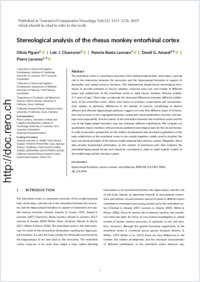Stereological analysis of the rhesus monkey entorhinal cortex
- Piguet, Olivia Laboratory of Brain and Cognitive Development, Institute of Psychology, University of Lausanne, Switzerland
- Chareyron, Loïc J. Laboratory of Brain and Cognitive Development, Department of Medicine, University of Fribourg, Switzerland
- Lavenex, Pamela Banta Laboratory of Brain and Cognitive Development, Institute of Psychology, University of Lausanne, Switzerland
- Amaral, David G. Department of Psychiatry and Behavioral Sciences, MIND Institute, University of California, Davis, California - California National Primate Research Center, University of California, Davis, California
- Lavenex, Pierre Laboratory of Brain and Cognitive Development, Institute of Psychology, University of Lausanne, Switzerland - Laboratory of Brain and Cognitive Development, Department of Medicine, University of Fribourg, Switzerland
-
01.09.2018
Published in:
- Journal of Comparative Neurology. - 2018, vol. 526, no. 13, p. 2115–2132
English
The entorhinal cortex is a prominent structure of the medial temporal lobe, which plays a pivotal role in the interaction between the neocortex and the hippocampal formation in support of declarative and spatial memory functions. We implemented design‐based stereological techniques to provide estimates of neuron numbers, neuronal soma size, and volume of different layers and subdivisions of the entorhinal cortex in adult rhesus monkeys (Macaca mulatta; 5–9 years of age). These data corroborate the structural differences between different subdivisions of the entorhinal cortex, which were shown in previous connectional and cytoarchitectonic studies. In particular, differences in the number of neurons contributing to distinct afferent and efferent hippocampal pathways suggest not only that different types of information may be more or less segregated between caudal and rostral subdivisions, but also, and perhaps most importantly, that the nature of the interaction between the entorhinal cortex and the rest of the hippocampal formation may vary between different subdivisions. We compare our quantitative data in monkeys with previously published stereological data for the rat and human, in order to provide a perspective on the relative development and structural organization of the main subdivisions of the entorhinal cortex in two model organisms widely used to decipher the basic functional principles of the human medial temporal lobe memory system. Altogether, these data provide fundamental information on the number of functional units that comprise the entorhinal‐hippocampal circuits and should be considered in order to build realistic models of the medial temporal lobe memory system.
- Faculty
- Faculté des sciences et de médecine
- Department
- Département de Médecine
- Language
-
- English
- Classification
- Biological sciences
- License
- License undefined
- Identifiers
-
- RERO DOC 323439
- DOI 10.1002/cne.24496
- Persistent URL
- https://folia.unifr.ch/unifr/documents/307356
Statistics
Document views: 80
File downloads:
- lav_sar.pdf: 159
